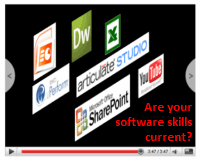 In my job, I get to interview many potential Organizational Change managers. It amazes me that so many are weak on the tools they need to use to communicate and deliver eLearning to end-users.
In my job, I get to interview many potential Organizational Change managers. It amazes me that so many are weak on the tools they need to use to communicate and deliver eLearning to end-users.End-users expect ever more sophisticated communication and training solutions to be delivered by their SAP Project management team. Nevertheless, a recent candidate with many years of experience told me he has to ask his nephew for help to use PowerPoint to add animations.
As change managers, we now need to write in HTML and deliver eLearning in Flash. We must produce videos and add audio with James Earl Jones-like voiceovers in three languages. So, how do you keep up your software skills, from Excel to Flash, and embrace all media, from wikis to metatags?
Let’s use the new media by making a quick check of YouTube where lots of free, state of the art software video training for change managers is available. The following are some video's demonstrating basic OCM tool skills.
Excel
This training video "Making a Gantt chart in Excel 2007" is great for learning how to develop a quick Training Plan in Excel 2007, plus it provides a quick refresher on how to create a chart. If you want to take it to another level check out "Excel Gantt Chart with Visual Indicator."
For managing communication plans and student class rosters I cannot live without VLOOKUP and Drop down menus. Some good video's include "VLOOKUP in Excel 2007" and "Creating drop-down menus in Excel 2007."
PowerPoint
The learning curve on Office 2007 and the new menu Ribbons changes the ground rules. Therefore, it is really good to get a refresher on how themes replace design templates in PowrPoint and how they are accessible in Excel and Word. Remember one part of IT Project Branding is consistent color coordination and use of design standards. A good overview video is "PowerPoint 2007 Demo: Add fonts, colors, and effects."
With so much video content now available – you will have to "Embed YouTube Video into PowerPoint 2007". Note you will need a live internet connection for this to work.
SharePoint
This MicroSoft application is going to be a big part of our lives going forward. We use it where I work and almost all companies that we have completed projects for over the last couple years. From document management to workspace collaboration it is a winner.
So here a few of my favorites "Explore the SharePoint Site", "Create a Customer Dashboard in SharePoint" and "Link SharePoint 2007 with Outlook 2007."
Just a recap. Keep your skills current or you will become as dated as yesterday’s rotary phone!

